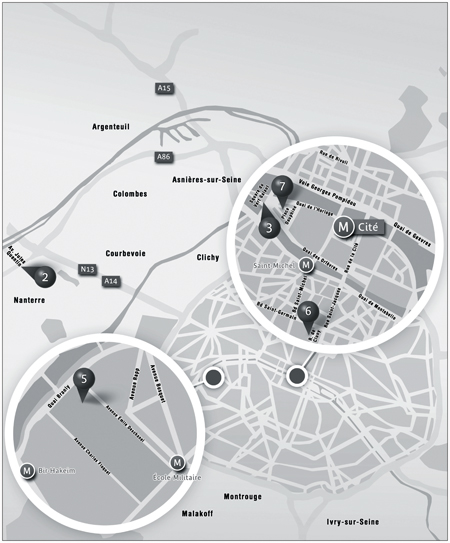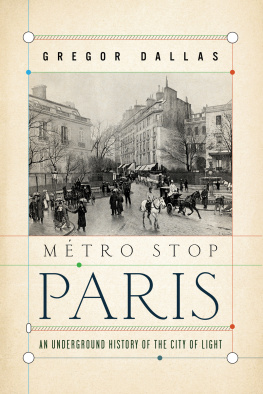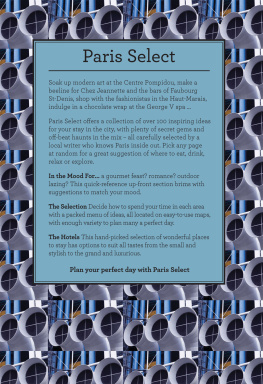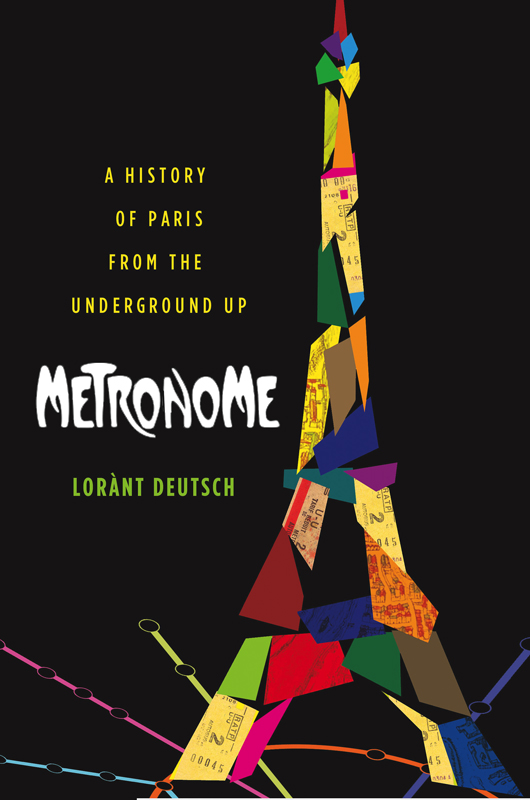
The author and publisher have provided this e-book to you for your personal use only. You may not make this e-book publicly available in any way. Copyright infringement is against the law. If you believe the copy of this e-book you are reading infringes on the authors copyright, please notify the publisher at: us.macmillanusa.com/piracy.
To Eddy Mitchell, whose Final Lecture first got me interested in history. And to my sister and my parents, who for my sake found a way to catch the weekly shows.
Contents
Introduction
Before the Crossing
My love for its history began many miles from Paris, in a village along the Sarthe River in the Loire Valley where I spent my childhood. My family and I left the village for vacations, but most special of all were the trips to the French capital with my grandparents. When we reached the outskirts of the citythe boulevard priphrique, or ring road around itI would gaze into the distance at its lights. Then into it we would plunge, and immediately be swept up in a whirl of hurrying pedestrians and swirling colors. I remember the bright neon signsthe green ones for the pharmacies and the red carrots for the tabacs, or tobacco shops. It was like Christmas, even in summer. Paris seemed to me a jungle, and being inside it both frightened and excited me.
At the age of fifteen I went to live in Paris, and took with me my love of its history. The city that had seemed so anonymous and impersonal, so beyond the scope of my comprehension, was now an open book. I knew almost no one; the names of the streets were my first companions. Most of all, it was through the subway system, the Mtro as it is known, short for Mtropolitain, that I discovered Paris. The Mtro introduced me to and took me through this enormous, humming hive of activity. It was a country boys ticket to ride, and I took full advantage, crossing, recrossing, and crisscrossing the city. At each stop I asked questions. Why was it called Les Invalides ? What was Chtelet, exactly? What Rpublique were they referring to, anyway? Who was tienne Marcel ? What did Maubert mean?
The Paris Mtro map represents the citys central nervous system; you can use it to trace its beginnings, when it was little more than a small island in the Seine. Each stop evokes some part of the pastnot simply of Parisian history but of French history as a whole. From La Cit to La Dfense oldest to newestthe Mtro serves as a moving time line, each station punctuating one of the twenty-one centuries of the citys history. Riding it carried me from the past to the present. And sometimes it went ahead of me, transforming the city into Frances capital before I had quite caught up with it.
In short, I learned history by riding the subway. While I was doing that I was also becoming involved in theater and then film, both of which are in their own way forms of time travel. By entering into the world of La Fontaine, for example, or Fouquet, Mozart, and Sartre, what I did was relive historyor, perhaps better, reenact history.
As a kid I channeled my love for French history through toy soldiers on the field of battle. Not much has changed. History remains the engine that drives my life and my desires; it is an endlessly rewarding archaeological site to which I keep returning, again and again, unearthing more mysteries and paradoxes and posing more questions.
This book will seek to serve as a sort of timekeeper, a metronome, measuring historys tempo, moving through time by means of Mtro stops. The subway lines, like Ariadnes thread, will guide you, just as they guided me, through tunnels echoing with the citys hopes, fears, and dreams. Watch the closing doors, please. First stop, Lutce.

The remains of Lutetia, discovered beneath the suburb Nanterre.. The only positively identified Gallic remains on le de la Cit, twenty feet below Square du Vert-Galant . The Eiffel Tower, sitting on what used to be the plain of Garanella, where thousands died in the battle for Lutetia.. The Pillar of the Boatmen.. The Place Dauphine on the le de la Cit, the birthplace of Paris.
First Century
Cit
Caesars Cradle
Arent you getting off at the next stop? This question was posed to me in a timid voice by a diminutive lady who had nudged me gently.
The subway cars brakes squealed loudly and metallically. Get off here? Actually, yes, I will get off here. le de la Cit is the ideal place to start: this island sits at the very heart of Paris and is its birthplace; appropriately enough, it has the shape of a cradle. The head, the heart, the very marrow of Paris, as Gui de Bazoches wrote in the twelfth century.
The le de la Cit stop consists of a series of wells dug deep into the citys entrailsalmost fifty feet (some twenty meters) below the water level of the Seine, and, as in Jules Vernes Voyage to the Center of the Earth, when you go down into it you have the feeling that time moves in reverse. No need of a volcano shaft to get down into the depths, or a Nautilus to dive leagues down below the surface. The Cit stop will do.
I vaulted up the metal circular stairs four at a time and headed toward the light, leaving the nice lady far behind. Once outside I ran smack into a scraggly cypress tree. I extricated myself only to find that now I was tangled up in the branches of an olive tree. Aha! I thought. An olive tree! A trace of the South, a faint echo of the Italian countryside . Actually, however, I was in the middle of the Cits flower market, which crowds right up to the edge of the subway entrance, as if both nature and history were trying to reclaim what once was rightfully theirs. Their success at this is illusory, for on one side the cars hum along in their endless descent down Boulevard Saint-Michel; on the other there is the same flood of cars heading in the other direction, climbing Rue Saint-Jacques.
After a few steps I reached the quays. A little farther along are the green boxes of the bouquinistes the vendors of secondhand books and old prints. I can never resist plunging in and always resurface with something, on this occasion two dog-eared histories of Paris. I sometimes think that the city is my wife. It is most definitely a woman, as Andr Breton put it in Nadja, his Surrealist novel: the triangle formed by the Place Dauphine represents the delta of Venus from whose womb it all emerged. I wanted to go in, not out; I wanted to return to a time before cars and the gray faades of the buildings, back to when the banks of the Seine were verdant slopes presiding over a muddy bog and the island was forested.
* * *
It is the 701st year following the founding of Rome and fifty-two years before the birth of Jesus Christ. le de la Cit is emptythere are no houses, no structures, nothing. Theres also as yet no sign of the Lutes of which Julius Caesar spoke in his History of the Gauls . Lutetia, town [ oppidum ] of the Parisii, located on an island in the Seine. Not very precise, of course, and indeed the proconsul had spent all of one day in the place, a day on which he was far more preoccupied with the gathering of the Gaul chiefs than he was with exploring the boundaries of this oppidum . In fact, when he came to write his history, Caesar knew it only through secondhand sources, relying on rumors and on hastily written military reports. He repeated what he had heard bruited about by his legionaries, whose descriptions were very sketchy.











